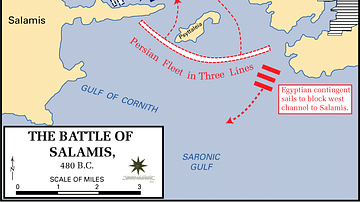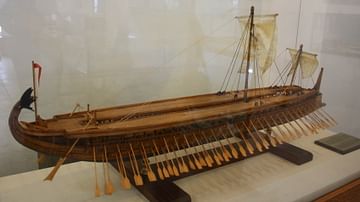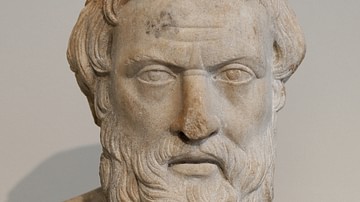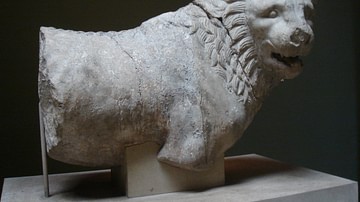
Artemisia I of Caria (l. 480 BCE) was the queen of the Anatolian region of Caria (south of ancient Lydia, in modern-day Turkey). She is most famous for her role in the naval Battle of Salamis in 480 BCE in which she fought for the Persians.
According to the Greek historian Herodotus (l. 484-425/413 BCE), she distinguished herself both for her conduct in battle and for the advice she gave the Persian king Xerxes (r. 486-465 BCE) prior to the onset of the engagement.
Her name is derived from the Greek goddess Artemis, who presided over the wild and was the patron deity of hunters. She was the daughter of King Lygdamis of Halicarnassus and a Cretan mother whose name is not known. Upon the death of her husband (whose identity is also unknown), Artemisia assumed the throne of Caria as regent for her young son Pisindelis. While it is probable that he ruled Caria after her, there is no record to substantiate this.
After the Battle of Salamis, she is said to have escorted Xerxes' illegitimate sons to safety at Ephesus (in modern-day Turkey) and, afterwards, no further mention is made of her in the historical record. The primary source for her achievements in the Greco-Persian wars is Herodotus of Halicarnassus and his account of the Battle of Salamis in his Histories, though she is also mentioned by Pausanias, Polyaenus, in the Suda, and by Plutarch.
Mistaken for Artemisia II
Every ancient account of Artemisia I depicts her as a brave and clever woman who was a valued asset to Xerxes on his expedition to conquer Greece except that of Thessalus who describes her as an unscrupulous pirate and a schemer. It should be noted, however, that later writers on Artemisia I seem to have confused some of her exploits with those of Artemisia II, the wife of King Mausolus of Halicarnassus (d. 350 BCE) who, among other achievements, commissioned the Mausoleum of Halicarnassus, one the ancient Seven Wonders of the World.
The conquest of the city of Latmus as related in Polyaenus (8.53.4), in which Artemisia I stages an elaborate and colorful festival some leagues from the city to draw the inhabitants out and then captures it without a fight, actually was the work of Artemisia II. This same holds true for the suppression of the revolt of Rhodes against Caria in which, after their defeat, the captured fleet of Rhodes sailed back to their home port leading ostensibly seized Carian ships and, in this way, the island was subdued without a lengthy engagement.
Artemisia & The Persian Expedition
Herodotus praises Artemisia I to such an extent that later writers (many of whom criticized Herodotus on a number of points) complain that he focuses on her to the exclusion of other important details regarding the Battle of Salamis. Herodotus writes:
I pass over all the other officers [of the Persians] because there is no need for me to mention them, except for Artemisia, because I find it particularly remarkable that a woman should have taken part in the expedition against Greece. She took over the tyranny after her husband's death, and although she had a grown-up son and did not have to join the expedition, her manly courage impelled her to do so…Hers was the second most famous squadron in the entire navy, after the one from Sidon. None of Xerxes' allies gave him better advice than her. (VII.99)
The Persian expedition was Xerxes' revenge on the Greeks for the Persian defeat at the Battle of Marathon in 490 BCE, and the Persian invading force is reported to have been the largest ever assembled in the world up to that point. Even if Caria, as part of the Persian Empire at the time, had been compelled to supply troops and ships, there would have been no reason for a sitting queen to lead or even accompany her soldiers to the field. Artemisia I's decision, then, was wholly her own.
She fought in the naval battle of Artemisium (which took place off the coast of Euboea and concurrently with the land engagement at Thermopylae in late 480 BCE) and distinguished herself as a commander and tactician. It is said she would fly either the Greek or the Persian standard from her ships, depending on circumstance and need, to avoid conflict until she positioned herself favorably for assault or escape.
The Battle of Artemisium was a draw but a tactical Persian victory in that the Greek fleet left the field after three days of engagement which allowed the Persian fleet to re-group and strategize. After the defeat of the Greek forces at Thermopylae, the Persian army marched from their base at the Hellespont across the mainland of Greece and razed the city of Athens. The Greeks had abandoned the city before the advance of the Persians and, under the leadership of Themistocles, had rallied their navy off the coast near the straits of Salamis.
Artemisia's Council to Xerxes
The Greek mainland had been taken, Athens burned, and Xerxes now called a war council to determine his next move. He could either meet the Greeks in a sea battle in hopes of decisively defeating them or consider other options such as cutting off their supplies and harassing their communities until they sued for peace. Herodotus gives an account of Artemisia I's role at the council and the respect she was accorded by Xerxes:
When they had sorted themselves out and were all sitting in their proper places, Xerxes sent Mardonius [his lead general] to test each of them by asking whether or not he should meet the enemy at sea. So Mardonius went around the whole group, starting with the king of Sidon, asking this question. The unanimous view was that he should engage the enemy at sea, with only a single dissenter – Artemisia. She said, “Mardonius, please take this message to the king for me, reminding him that I did not play a negligible or cowardly role in the sea battles of Euboea: Master, it is only right that I should tell you what is, in my honest opinion, the best course of action for you. So here is my advice: do not commit the fleet to battle, because at sea your men will be as inferior to the Greeks as women are to men. In any case, why should you have to run the risk of a sea battle? Have you not captured Athens, which was the point of the campaign? Do you not control the rest of Greece? There is no one to stand against you. Everyone who did so has met with the treatment he deserved. I will tell you what I think the future holds in store for our enemies. If you do not rush into a sea battle, master, but keep your fleet here close to shore, all you need do to gain all your objectives without any effort is either wait here or advance into the Peloponnese. The Greeks do not have the resources to hold out against you for any length of time; you will scatter them and they will retreat to their various towns and cities. You see, I have found out that they do not have provisions on this island of theirs, and if you march overland towards the Peloponnese, it is unlikely that the Greeks from there will remain inactive or will want to fight at sea in defence of Athens. However, if you rush into a sea battle straight away, I am afraid that the defeat of the fleet will cause the land army to come to grief as well. Besides, my lord, you should bear this in mind too, that good men tend to have bad slaves, and vice versa. Now, there is no one better than you, and you do in fact have bad slaves, who are supposed to be your allies – I mean the Egyptians, Cyprians, Cilicians, and Pamphylians, all of whom are useless.”
These words of Artemisia's to Mardonius upset her friends, who assumed that the king would punish her for trying to stop him committing himself to a sea battle, while those who envied and resented her prominence within the alliance were pleased with her reply because they thought she would be put to death. But when everybody's opinions were reported back to Xerxes, he was delighted with Artemisia's point of view; he had rated her highly before, but now she went up even further in his estimation.
Nevertheless, he gave orders that the majority view was the one to follow. He believed that his men had not fought their best off Euboea because he had not been there, and so now he prepared to watch them fight. (VIII.67-69)
Artemisia at Salamis
Following the Battle of Artemisium, the Greeks had placed a bounty on Artemisia I's head, offering 10,000 drachmas to the man who captured or killed her. Even so, there is no evidence that the queen hesitated to join the sea battle, even though she had advised against it. The Greeks tricked the Persian fleet into the straits of Salamis, feigning a retreat, and then surprised them in attack. The smaller, more agile, ships of the Greeks were able to wreak enormous damage on the larger Persian ships while the latter, owing to their size, were unable to navigate effectively in the narrow confines. Herodotus writes:
I am not in a position to say for certain how particular Persians or Greeks fought, but Artemisia's behavior caused her to rise even higher in the king's estimation. It so happened that in the midst of the general confusion of the Persian fleet, Artemisia's ship was being chased by one from Attica. She found it impossible to escape, because the way ahead was blocked by friendly ships, and hostile ships were particularly close to hers, so she decided on a plan which did in fact do her a lot of good. With the Attic ship close astern, she bore down on and rammed one of the ships from her own side, which was crewed by men from Calynda and had on board Damasithymus, the king of Calynda. Now, I cannot say whether she and Damasithymus had fallen out while they were based at the Hellespont, or whether this action of hers was pre-meditated, or whether the Calyndan ship just happened to be in the way at the time. In any case, she found that by ramming it and sinking it she created for herself a double piece of good fortune. In the first place, when the captain of the Attic ship saw her ramming an enemy vessel, he assumed that Artemisia's ship was either Greek or was a defector from the Persians fighting on his side, so he changed course and turned to attack other ships.
So the first piece of good fortune was that she escaped and remained alive. The second was that, although she was quite the opposite of the king's benefactor, her actions made Xerxes particularly pleased with her. It is reported that, as Xerxes was watching the battle, he noticed her ship ramming the other vessel and one of his entourage said, 'Master, can you see how well Artemisia is fighting? Look, she has sunk an enemy ship!' Xerxes asked if it was really Artemisia and they confirmed that it was because they could recognize the insignia on her ship, and therefore assumed that the ship she had destroyed was one of the enemy's – an assumption that was never refuted, because a particular feature of the general good fortune of Artemisia, as noted, was that no one from the Calyndan ship survived to point the finger at her. In response to what the courtiers were telling him, the story goes on, Xerxes said, “My men have turned into women and my women into men!” (VIII.87-88)
The Battle of Salamis was a great victory for the Greeks and a complete defeat for the Persian forces. Xerxes could not understand what had gone so wrong and was afraid that the Greeks, now emboldened by their victory, would march to the Hellespont, cut down the Persian forces stationed there, and trap him and his forces in Greece. Mardonius suggested a plan whereby he would remain in Greece with 300,000 forces and subdue the Greeks while Xerxes returned home.
The king was pleased with this plan but, recognizing that Mardonius had also been among those who supported the disastrous sea battle, called another council to determine the proper plan of action. Herodotus writes:
He convened a meeting of Persians and, while he was listening to their advice, it occurred to him to invite Artemisia along too, to see what she would suggest, because of the earlier occasion on which she had turned out to be the only one with a realistic plan of action. When she came, he dismissed everyone else. (VIII. 101)
Artemisia I suggested that he follow Mardonius' plan, saying,
I think you should pull back and leave Mardonius here with the troops he's asking for, since he's offering to do that of his own free will. My thinking is that if he succeeds in the conquests he says he has set himself, and things go as he intends, the achievement is yours, Master, because it was your slaves who did it. But if things go wrong for Mardonius, it will be no great disaster as regards your survival and the prosperity of your house. I mean, if you and your house survive, the Greeks will still have to run many a race for their lives. But if anything happens to Mardonius, if doesn't really matter; besides, if the Greeks win, it won't be an important victory because they will only have destroyed one of your slaves. The whole point of this campaign of yours was to burn Athens to the ground; you've done that, so now you can leave. (VIII.101-102)
Xerxes accepted Artemisia's advice this time and withdrew from Greece, leaving Mardonius to fight the rest of the campaign for him. Artemisia I was given charge of escorting Xerxes' illegitimate children to safety in Ephesos and, as previously noted, then vanishes from the historical record. Mardonius was killed at the Battle of Plataea the following year (479 BCE) which was another decisive victory for the Greeks and put an end to the Persian invasion of Europe.
The Legend of Her Death
Pausanias claims that there was a marble statue of Artemisia I erected in the agora of Sparta, in their Persian Hall, which was created in her honor from the wreckage left behind by the invading Persian forces. The writer Photius (l. c. 858 CE) records a legend that, after she brought Xerxes' sons to Ephesus, she fell in love with a prince named Dardanus. For unknown reasons, Dardanus rejected her love and Artemisia I, in despair, threw herself into the sea and drowned.
There is nothing in the reports of the ancient writers which gives any credence to this legend, however. The story is similar to those set down by Parthenius of Nicea (d. 14 CE) in his Erotica Pathemata (Sorrows of Romantic Love), a very popular work of tragic love stories, whose purpose seems to have been to serve as a warning on the perils of romantic attachments.
It is possible that Photius, writing much later, chose to draw on the figure of Artemisia I to illustrate a similar lesson. While there is nothing in the record to corroborate Photius' version of her death, there is also nothing which contradicts it save the character of the woman as depicted in the ancient histories. Her recent fictional portrayal in the 2014 film 300: Rise of an Empire is in spirit with the ancient sources and hardly supports the claim that such a woman would end her life over the love of a man.




